What You Need to Know:
"Pyoderma literally means, 'pus in skin'. It's the most common canine skin disease. The condition is characterized by dog pimples, lumps, bumps and areas of skin redness. It can be found in specific areas or all over the dog's body. Pyoderma usually occurs as the result of another underlying disease or condition or risk factors such as a depressed immune system, reducing the body's ability to fight off bacterial skin infections. It is caused by inflammation, infection (bacterial or viral), infestation (parasitic) or even cancer.
In Adult Dogs skin infections take hold when the skin becomes:
- Broken or injured
- Skin blood flow has become impaired
- The immune system has been suppressed
- Normal skin bacteria has been changed or altered.
In dogs that are susceptible to skin allergy symptoms (allergic dermatitis), often the itching and scratching will introduce bacteria into the skin.
In Puppies (puppy pyoderma), areas on the body with thin amounts of hair such as the underarms or groin often develop pyoderma. Causes in puppies include:
- Hormonal imbalance
- Thyroid disease
- Fungal skin infection
- Yeast infection
- Ticks
- Fleas
A veterinarian will diagnose the condition after taking a history and looking at the clinical signs. A Vet might test for hyperadrenocortism (Cushing's Disease) or Hypothyroidism. Other helpful tests are skin cultures, fungal cultures or antibiotic sensitivity testing. If allergy (allergic dermatitis) is suspected, a Vet might recommend allergy tests.
Depending on the severity of the condition (surface or deep into the skin), treatment in most cases will include the combination of antibiotics (two to six weeks) and shampoo therapy (that contains chlorhexidine or benzoyl peroxide). If the condition does not respond to treatment, a veterinarian will either refer the case to a veterinary dermatologist, increase the dosage of antibiotics, choose a different antibiotic, search for another cause or introduce additional therapy in whirlpools or baths."
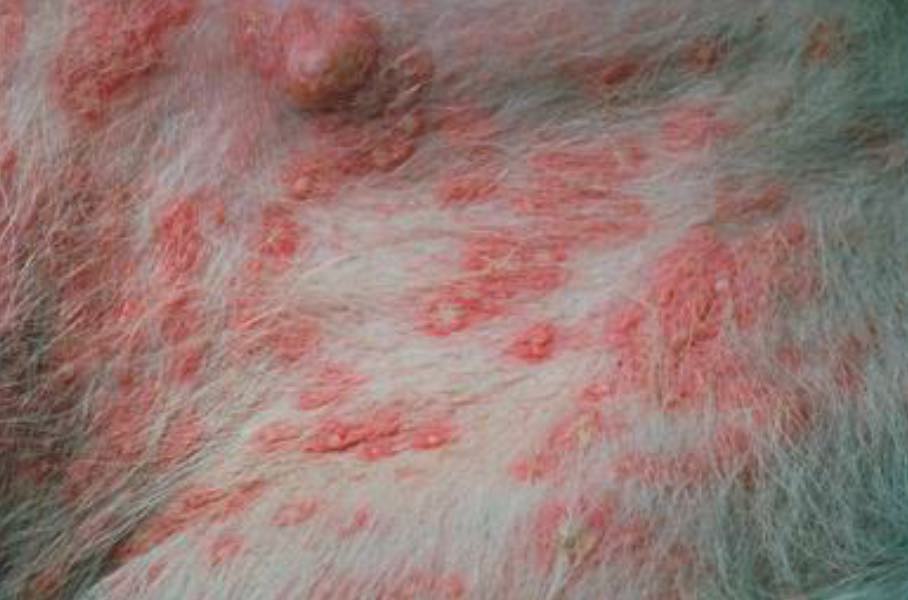 Pyoderma in Dogs is Associated with skin Pustules or Papules. They have a white pus-filled center, and are commonly raised and red. Other symptoms can include itch, hair loss, flaky skin patches, dry skin or circular crusts. In short haired dogs the skin may appear to be raised in areas. The coat may also look moth-eaten.
Pyoderma in Dogs is Associated with skin Pustules or Papules. They have a white pus-filled center, and are commonly raised and red. Other symptoms can include itch, hair loss, flaky skin patches, dry skin or circular crusts. In short haired dogs the skin may appear to be raised in areas. The coat may also look moth-eaten.Overview of Pyoderma in Dogs
The most commonly diagnosed infectious skin disease is pyoderma in dogs, which means pus in the skin. In overall diagnoses, canine bacterial pyoderma is second only to flea allergy dermatitis in frequency. The problem is seen more often in dogs than any other animal on the planet. Most of these infections are usually superficial and secondary to an underlying condition such as allergy, parasitic infestation or a dermal cancer. Some parts of dog body such as facial folds, lip folds, feet, armpits, and neck folds are since moist and warm areas, so contains higher bacterial count as compared to other parts, thus are more at risk for an infection. Dogs are more susceptible to pyoderma in humid environment, as compared to dry conditions.
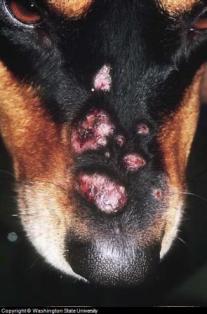
Pyoderma is either superficial or secondary to other conditions. Most skin infections are secondary, which means that it is caused by another condition. For example, itching and scratching can result from some other condition, which causes the dog to open the skin to bacteria. Since the itching caused the skin to open, the bacteria is referred to as being secondary. In the case of pyoderma, the infection can start on its own. The bacteria is introduced to the skin through a dogs normal licking and grooming behaviors.
Dog’s suffering from pyoderma often have some other underlying condition that makes the skin barrier dog more susceptible to the condition including:
- Skin injury or trauma from scratching due to dog skin Itch, trauma from bites, wounds or scratches
- Foreign objects such as Ingrown hair, splinters
- Skin inflammation
- Hair follicle diseases
- Hardening of the cells (cornification where the keratin tin the skin does not form properly)
- Grooming issues in long haired dogs
- Endocrine disorders (hypothyroidism, hyperglucocorticoidism, Cushings disease, sex hormone, growth hormone)
- Immune system problems
- Dog skin disorders where the skin is too oily or flaking (seborrhea, sebaceous gland inflammation, sebaceous adenitis or schnauzer comedo)
- Dog Allergies: skin inflammation due to an allergic response to environmental, inhaled or dog food allergies
- Parasitic diseases such as fleas, Demodicosis or mange (a skin condition caused by mites)
- Other sources of dog skin infection: Yeast like fungal infection (different types are called Malassezia dermatitis or dermtophytosis).
- Color dilution alopecia (hair loss)
- Metabolic disorders such as canine liver disease
- Autoimmune disease such as canine lupus, canine pemphigus
- Cancers (called neoplasia)
- Hypersensitivity to bacteria
- Long term use of Steroidal medications
Superficial Pyoderma (Superficial Bacterial Folliculitis)
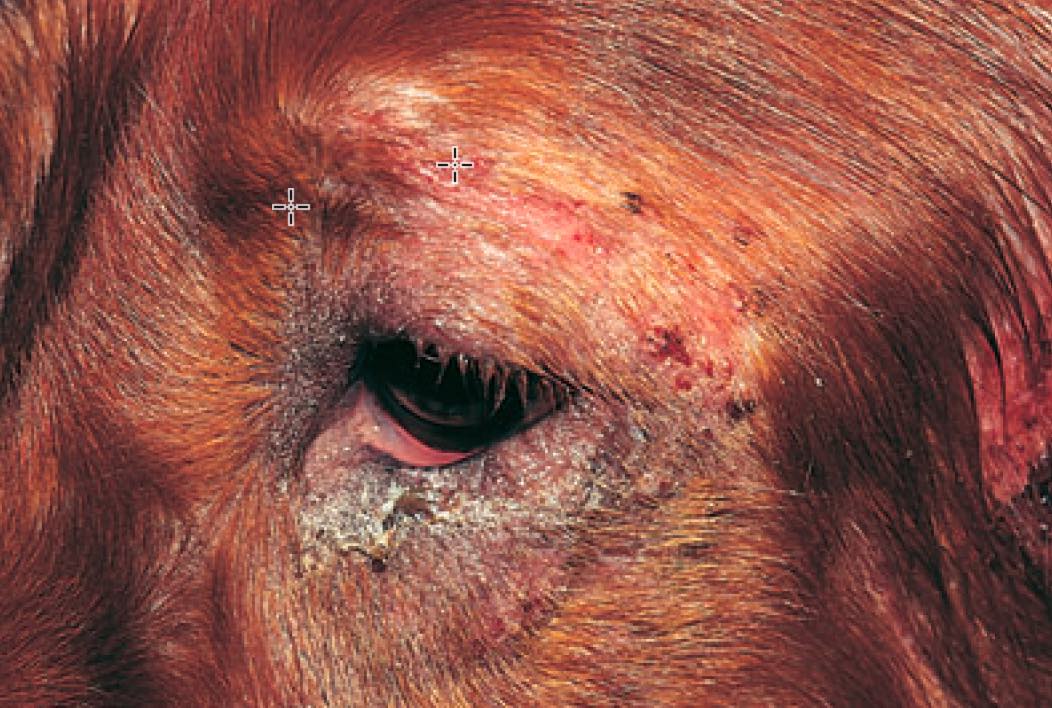 Pyoderma Around Dog Eye Including alopecia (hair loss), Crusts and Papules. Symptoms are consistent with Bacterial Folliculitis.
Pyoderma Around Dog Eye Including alopecia (hair loss), Crusts and Papules. Symptoms are consistent with Bacterial Folliculitis.Superficial pyoderma, also known as canine superficial bacterial folliculitis, is a bacterial infection that affects a dog's skin at a superficial level, meaning it affects the upper layers of the skin. It is most common skin condition in dogs.
This condition typically involves infection in the hair follicles, leading to pustules (small, pus-filled bumps) and red, inflamed areas on the skin. It's typically caused by the bacteria Staphylococcus pseudintermedius, which is a normal inhabitant of a dog's skin but can cause problems when it penetrates the skin's surface due to damage or other underlying issues such as allergies, hormonal imbalances, or a weakened immune system. This mostly happens if the bacterial count is more than normal or the conditions are too humid.
Symptoms of canine superficial pyoderma in dogs can include:
- Itchy skin
- Redness
- Pustules
- Scaly patches
- Hair loss
- Areas of darkened (hyperpigmented) skin
- "Greasy" or foul-smelling skin
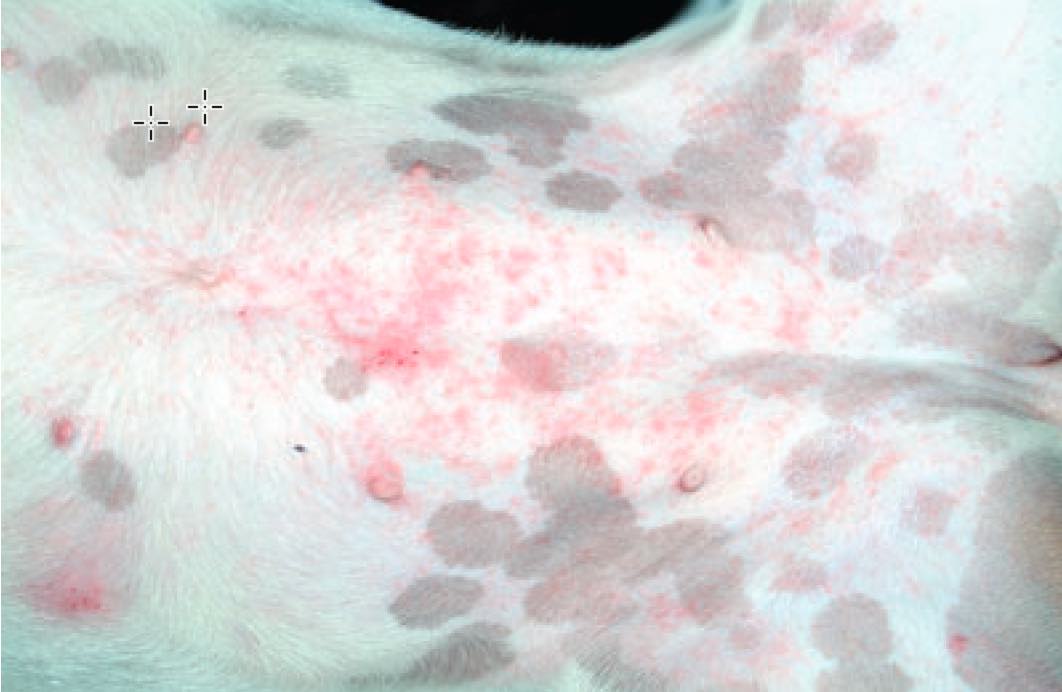 Superficial Pyoderma on Dog Belly caused by Itch associated with allergic dermatitis and the bacteria Staphyloccus schleiferi.
Superficial Pyoderma on Dog Belly caused by Itch associated with allergic dermatitis and the bacteria Staphyloccus schleiferi.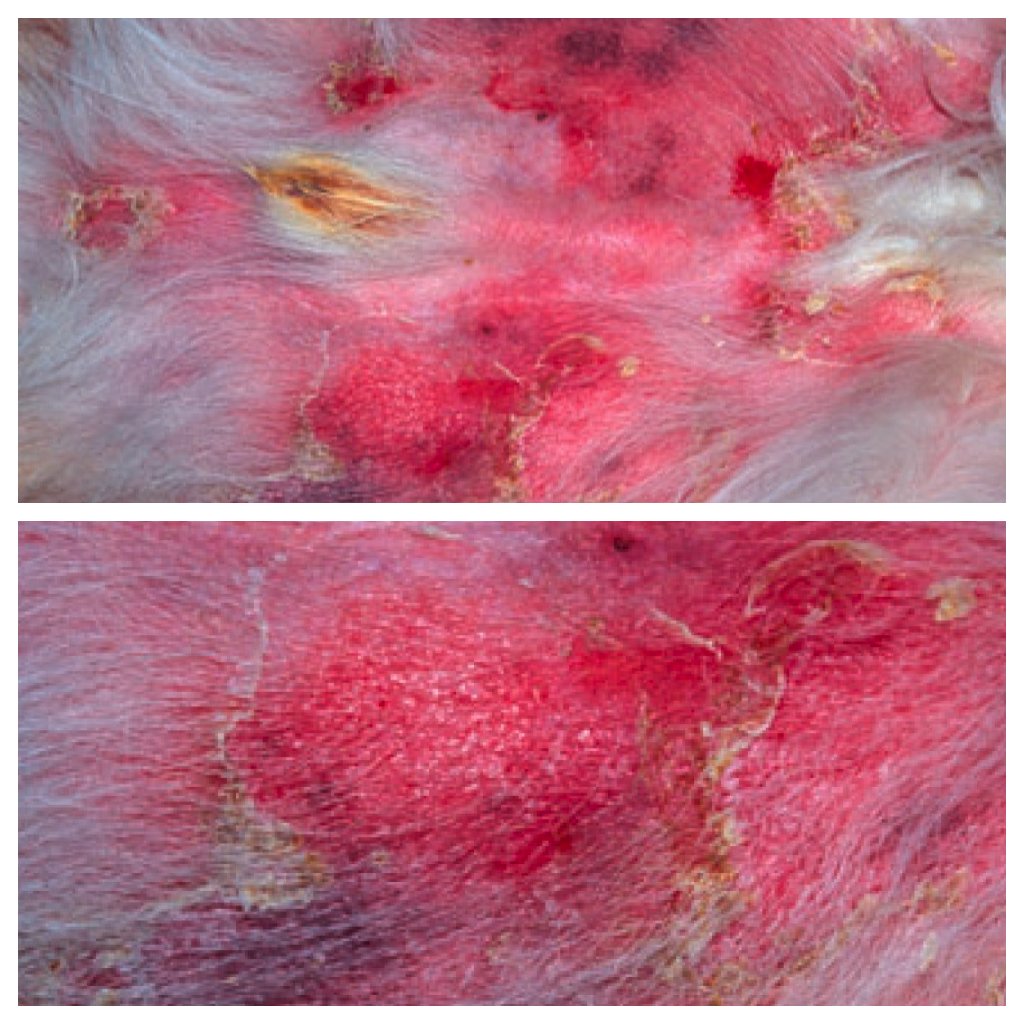 Pictures of Severe Dog Pyoderma (erythematous dermatitis). Pyoderma causes by a drug-resistant infection.
Pictures of Severe Dog Pyoderma (erythematous dermatitis). Pyoderma causes by a drug-resistant infection.Relationship Between Allergic Dermatitis and Pyoderma
Allergic dermatitis and pyoderma are both conditions that can affect a dog's skin, and there's often a relationship between the two.
Allergic dermatitis in dogs is typically a reaction to environmental allergens like pollen, dust mites, or food ingredients. When a dog with allergies comes into contact with these allergens, the immune system overreacts, resulting in inflammation and itching. Dogs will often respond to the itch by scratching, biting, and licking the affected areas, which can cause further inflammation and secondary infections.
Pyoderma is a bacterial skin infection in dogs, which often occurs as a secondary condition to other health issues like allergies or parasitic infections. Pyoderma can occur when the dog's skin is damaged (e.g., by scratching due to allergies) and bacteria that normally live on the skin's surface penetrate the deeper layers of the skin. This can cause symptoms like redness, swelling, pustules, hair loss, and crusty skin.
So, allergic dermatitis in dogs can lead to pyoderma because the irritation and itching caused by the allergic reaction can lead to scratching and skin damage, which provides an opportunity for a bacterial infection to develop. Conversely, a dog suffering from pyoderma may also have underlying allergic dermatitis that needs to be addressed in order to fully resolve the skin issues.
It's important for a veterinarian to identify and treat both conditions if they're present, which may include addressing the underlying allergies, providing antibiotics or other treatments for the bacterial infection, and implementing strategies to help prevent future skin infections.
Puppy or Juvenile Pyoderma
When a puppy is weaning, several breeds are predisposed to pyoderma, with higher than average instances in Gordon Setters, Golden Retrievers and Dachshunds. Puppy pyoderma symptoms includes anorexia (failure to eat, loss of appetite), lymphadenopathy in the lymph nods and fever. Abscesses can also form, which are referred to as puppy strangles.
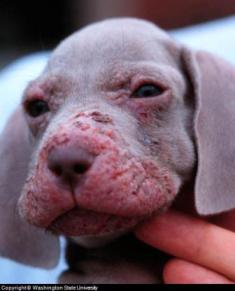
Pyoderma Symptoms
Pus filled dog skin pimples, bumps or lumps tend to appear on the dog’s groin, armpit, between the toes, at the stifle joint (where leg bends/knee), elbow and at the hocks (ankle joint). Other symptoms includes bulls eye lesions, scabs, skin flakes and dog skin redness. The most common sign of pyoderma in dogs is scaling of skin. Superficial pyoderma may appear as bald patches, where irritation is variable. At margins of hair-loss, redness and pimples etc can appear.
Pyoderma in dogs is usually characterized by symptoms of pain, odor, crusting, irritation and secretions of pus and blood. Swelling, redness, blisters and fever are classic signs of inflammation.
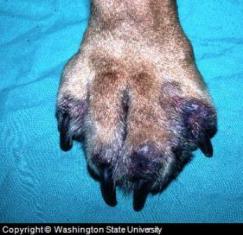
The condition can be seen in a specific or localized area, or all over the dog’s body.
Diagnosis
Diagnosis of pyoderma in dogs can mostly based upon signs. However, part of the canine pyoderma diagnostic process will be to determine if the patient has any underlying cause or predisposing factors that allowed the pyoderma to take hold, thus to also determine whether pyoderma is superficial or secondary to other conditions. A normally functioning immune system should be able to fight off bacterial infection, which is why a vet will look for anything that is disrupting this normal protective function of the body.
Here's a general process that might be followed to diagnose this condition:
- History and Physical Examination: The vet will start with a thorough history and physical examination of your dog including current symptoms, frequency of symptoms, past treatments, any clinical signs of disease etc. The physical examination typically involves close inspection of the skin and coat for signs of infection. The vet will look to see if the only symptom is pyoderma or are there other potential problems. If the dog is suffering from itch (pruritus), a determination will be made if the itch is due to any underlying condition.
- Cytology: If pyoderma is suspected, a procedure called cytology is often done to get a bacterial culture. This involves collecting samples from the affected skin areas using a swab, slide or tape and examining them under a microscope. The vet will look for the presence of bacteria and/or yeast. This step is crucial in diagnosing pyoderma as well as differentiating it from other skin conditions.
- Culture and Sensitivity Test: If cytology confirms a bacterial infection, a culture and sensitivity test may be done. This test helps identify the exact type of bacteria causing the infection and which antibiotics it is sensitive or resistant to. It involves growing the bacteria in a lab and exposing it to various antibiotics to see which ones are effective.
- Skin Biopsy: In severe or chronic cases that do not respond to treatment, or if other diseases are suspected, a skin biopsy may be performed. This involves removing a small piece of skin and examining it under a microscope.
- Additional Testing: If the vet suspects an underlying condition is causing recurrent pyoderma, additional tests like blood tests, allergy testing, hormonal tests, etc. might be needed.
After performing these tests, the vet should be able to confirm a diagnosis of pyoderma and recommend a treatment plan. Treatment usually involves antibiotics and medicated shampoos or topicals. In case of an underlying condition, that would also need to be addressed to prevent recurrence of the infection.
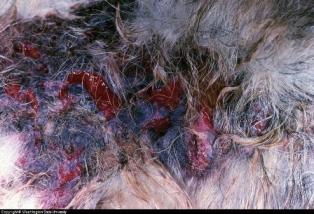
Diagnostic Classifications
Pyoderma in dogs has different classifications including:
- Surface Canine Pyoderma or superficial canine pyoderma is characterized by acute moist dermatitis (surface inflammation) symptoms such as hotspots or areas injured by the dog from scratching or itching. Pyoderma on the skin surface is often found in the skin folds (intertrigo) which refers to any skin inflammation, ulceration or openings at the skin folds. These include areas of the body such as the lip folds, vulvar fold, any folds due to obesity, facial folds, skin folds at the tail and mucocutaneous pyoderma which refers to pyoderma in the lip folds (common in German Shepherds).
- Superficial Canine Pyoderma is characterized by a condition called impetigo, which is another name for a localized skin infection. Other symptoms are superficial folliculitis, which are puss filled pimples at the base of the hair follicles and pyoderma that is spreading across the surface of the skin.
- Deep Canine Pyoderma refers to deep inflammation on the hair follicle, and the possible presence of out types of skin conditions such as canine acne. Another symptom is cellulites, which is a bacterial infection just under the skin surface. The skin will appear as if there are small crevices in the skin which are bloody or are oozing pus. Sometimes, the dog would suffer with recurring pyoderma, which usually happens if the underlying cause is not treated, glucocorticoid drugs are used in excess or there had been an inappropriate use of prescribed antibiotics.
Treatment of Pyoderma in Dogs
Most cases of canine pyoderma can be managed with antibiotics 1x of 2x per day (erythromycin, lincomycin, oxacillin, cephalexin, enrofloxacin, marbofloxacin, cefpodoxime, cefadroxil, ormetroprim-potentiated sulfonamides). Antibiotics will be continued for 1 week past the point that the condition clears which is a minimum of 3 weeks to 6 weeks. The dosage will be based on the pyoderma classification. In most cases, it is recommended that antibiotic treatment should last for at least 3 weeks and preferably for 4 weeks. The thumb rule though is that all signs (except hair regrowth and resolution of pigmentation) should resolve at least a week before you stop administering antibiotics. That is why, in severe cases like that of recurring- or deep-pyoderma the antibiotic treatment may need to continue for 8 - 12 weeks, so that dog can heal completely. Topical antibiotics are also prescribed in such cases.
In some cases, bacterial cultures and sensitivity testing may be performed to guide antibiotic selection. This involves isolating the bacteria and testing it against different antibiotics to see which ones are most effective. Overall, while antibiotic resistance is a concern in treating canine pyoderma, careful management and a comprehensive approach to the dog's health can help mitigate the risks. So, in chronic and long-term cases, it's important to closely follow the veterinarian's instructions.
Antibacterial shampoo therapy can be helpful as an alternative to antibiotics for some types of surface pyoderma in dogs. It can also be used in addition to antibiotics in all forms of the disease. Shampoo therapy can help to reduce symptoms such as itch and any related pain.
Topical therapy with a shampoo should be left on the skin surface for 10 minutes before rinsing and should be used a minimum of 1x per week, with 2x per week thought to be better. Shampoo should contain benzoyl peroxide such as Pyoben, benzoyl peroxide and sulfur, acetic acid (2%) + boric acid (2%), chlorhexidine, ethyl lactate or triclosan. More on each shampoo type is below:
- Acetic acid (2%) + Boric Acid (2%) is available in shampoo, solution and wipes. It has an antibacterial effect, and studies show the solution works well to eliminate the bacteria Staphylococcus pseudintermedius.
- Benzoyl Peroxide (2.5% - 5%) works by damaging bacterial membranes. The antibacterial effect an last for 48 hours and has a follicular flushing action. Very helpful for dogs that suffer from greasy seborrhea.
- Chlorhexidine (2% - 4%) has broad-spectrum antiseptic activity. It has good residual activity even after 29 hours on the skin. It is superior to povidone iodine and ethyl lactate and is non drying compared to benzoyl peroxide.
For cases of deep pyoderma in dogs, hair should be clipped and the patient should receive antibacterial soaks or bathing in a whirlpools (preferred). Bath or whirlpool Water should be warm and contain an antibacterial. This can be providone-iodine or chlorhexidine. If in a hospital, dog’s benefit from 1x per day or 2x per day soaking for 15 to 30 minutes. Dogs should improve in 2 to 3 weeks.
If no improvement is seen, additional investigation is needed.. Other possible explanations are selection of the wrong antibiotic, an antibiotic dosage that was too low, or a wrong diagnosis. Dogs with recurrent pyoderma, meaning the condition returns after clearing, should be referred to a veterinary dermatologist. See our guide to dog skin pimples for additional causes.
Have A Question about Your Dog's Skin Condition? Our Team Will Answer It for Free!
Do you have a question or comment? Share it!
Our editors will pick 1 question to answer each week. Please include your dog's age, breed, medical history, medications and if possible, a picture of the condition.
We will do our best to get back to you quickly (it depends on how many questions we receive each day). If you do require an immediate response we suggest using this online dog veterinary service that is available now.
Other Reader Dog Skin Related Questions and Vet Suggestions
Click below to see contributions from other visitors to this page...
Puppy Rash on Belly - Possible Causes and Treatment Not rated yet
What is an at home treatment for this rash on my dog. if I cannot afford a vet visit during holidays.
Suggestions From Our Editor on Causes and Treatment …
Sudden Dog Rash - What Are The Causes and Treatment Options Not rated yet
My dog had this rash come up all of a sudden. She received her lepto shot two days ago… would this be an adverse effect of that vaccine?
Suggestions …
Cause and Treatment of Rash on Dog Belly Not rated yet
Is this rash something I can treat with Cortisone 10 and or Benadryl? It looks like pyoderma.
Editor Suggestion for Treating a Dog Belly Rash
…
Dog Has Rash in Groin Not rated yet
She has been playing outside in hose water and rolling in the grass. We gave her a bath and saw that rash around her groin and belly. No bugs that I can …
Pyoderma? Abscess? Skin irritation? Not rated yet
We thought she had gotten insect bites and aggravated them. Swelling went down and I have been using antiseptic shampoo and iodine to clean. Tried to clean …





